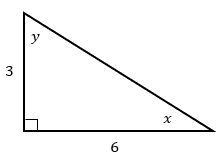Understanding how to find missing side lengths in right triangles is essential in trigonometry, especially when given one side and one angle. This process involves using trigonometric functions and the Pythagorean theorem to solve for unknown values.
To begin, if you have a right triangle with one known angle and one known side, the first step is to determine any missing angles. For instance, if you know one angle is 37 degrees, you can find the other non-right angle by subtracting from 90 degrees: 90^\circ - 37^\circ = 53^\circ. This gives you the second angle, which is crucial for applying trigonometric functions.
Next, you can use the SOHCAHTOA mnemonic to choose the appropriate trigonometric function. This tool helps you remember the relationships between the angles and sides of a right triangle. For example, if you need to find the side opposite the 37-degree angle, you can use the sine function, which is defined as:
\sin(\theta) = \frac{\text{opposite}}{\text{hypotenuse}}
In this case, if the hypotenuse is 5, the equation becomes:
\sin(37^\circ) = \frac{x}{5}
To solve for the missing side x, multiply both sides by 5:
x = 5 \cdot \sin(37^\circ
Using a calculator in degree mode, you would find that x is approximately 3.009, which can be rounded to 3.
After finding one side, the next step is to use the Pythagorean theorem to find the remaining side. The theorem states:
a^2 + b^2 = c^2
Here, if you let a be 3 (the side you just calculated) and c be 5 (the hypotenuse), you can set up the equation:
3^2 + b^2 = 5^2
This simplifies to:
9 + b^2 = 25
Subtracting 9 from both sides gives:
b^2 = 16
Taking the square root of both sides results in:
b = \sqrt{16} = 4
Thus, the missing side b is 4. By applying trigonometric functions and the Pythagorean theorem, you can effectively solve for all missing sides in any right triangle when given one side and one angle.




